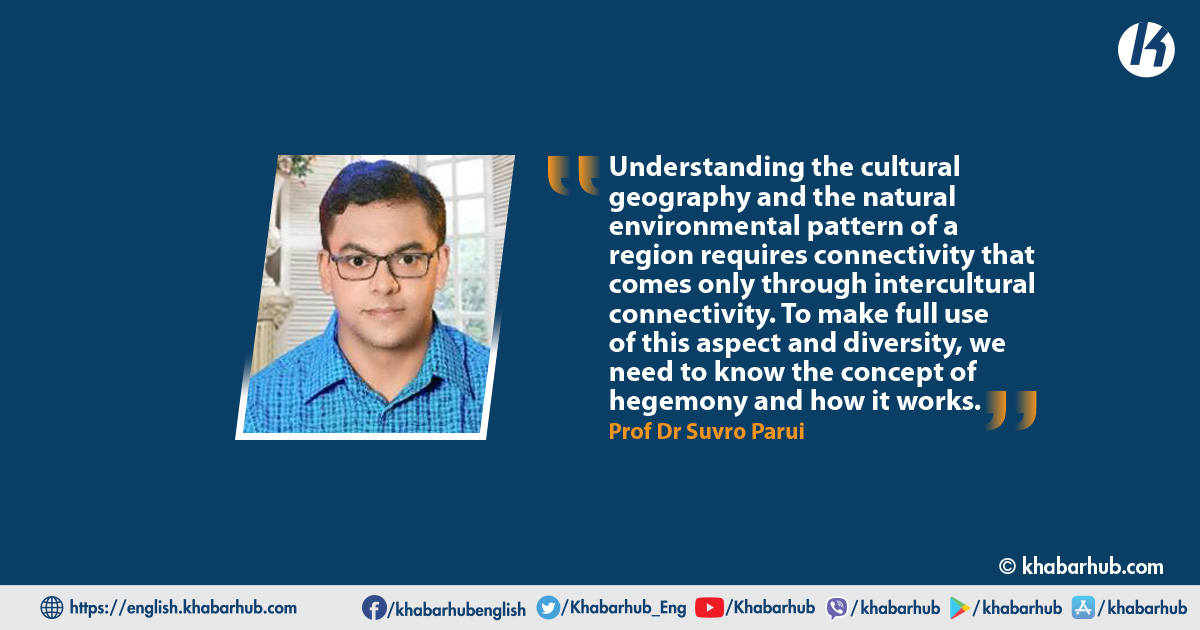India and China both have witnessed the sign wave of a growing economy and the investment in Asia and beyond with a homogenized reverential fear and apprehension.
The capricious scale of these investments is resetting the political arrangements around South Asia. Lion shares of the investments are channelized through Belt and Road Initiative (BRI), an arrangement started under President Xi Jinping to make a Sino-driven worldwide exchanging organization and range of prominence.
The growing economic and political impact of Beijing in India’s area can’t be completely perceived without a strong base of full information and acquiring information, connectivity is the main driver in the entire blueprint; amongst all connectivity, language has its special reference and it is significant in setting the path for both Asian giants and significant, extended visual examination and insightful exercise to gather data, focusing on India’s neighbors in South Asia.
Understanding the cultural geography and the natural environmental pattern of a region requires connectivity that comes only through intercultural connectivity.
To make full use of this aspect and diversity, we need to know the concept of hegemony and how it works. With time changes take place.
After WW II, when entire east Asian communities turn up in the first lane of the corridor, consumption of energy increased; despite lack of resources(energy resources), they starts importing oil from middle eastern countries mostly.
Malacca become the most reasonable and mainstream route for the oil stakeholders in the Middle East region.
Today, 90% of the oil big tankers in China’s extreme South China Sea will take the course of Malacca. China has sent for a long time and plans to guarantee oil wellbeing through broadened wellsprings of oil imports.
As China’s defense spending has risen from around $19 billion in 1989 to $228 billion in 2016 dollars, and on the present day it’s $320 billion the cost as a percentage of GDP has barely changed, probably remaining below 2 percent.
Up until this point, it has just assumed a part in mitigating the weight on the Malacca course. Similarly, created economies, for example, Japan, South Korea, Taiwan, and Hong Kong additionally rely upon Malacca for endurance, and mechanical items delivered in different nations and districts should likewise be traded along the reverse channel.
It is difficult to anticipate this long energy repository, the Strait of Malacca is Singapore toward one side and Banda Aceh at the other; in any case, if the presence of the Andaman Islands keeps on fortifying, it might be possible that it will end up being another “interface Or a link”.
Hence, Malacca turned into the immediate lifeline of East Asia. The Andaman Islands resemble another gateway that is outside Malacca.
Albeit restricted by the national power of India at that point and the drawn-out worldwide circumstance, this gateway has been available to the world, however, its significance in the advanced and contemporary international structure has not vanished. Unobtrusively rises on national power come into existence.
There is no doubt on India’s latent capacity and India needs to be an extraordinary force. Yet, incredible forces should have adequate financial and military clout, in addition to a huge populace and a feeling of verifiable significance.
Desires should consistently be coordinated with abilities. Living in a fantasy land about advancement and impact should be tempered by a comprehension of how India should deal with accomplishing its points, but during the 1980s, India attempted to reinforce its military presence in the archipelago.
Malaysia and Indonesia kept up a serious extent of cautiousness against this, stressing India would utilize the military bit of leeway brought by the island’s military to stop encompassing zones.
Around then, India’s public and military force didn’t have a staggering favorable position over the previously mentioned nations, and its strategy was generally moderate, so it was more limited and just kept up a low-level garrison.
India still stands strong at the North Indian Ocean, however, the inheritance of British India, still in place; northeast and the Andaman Islands are the best examples and seeds of the eastward expansion of the colonial regime.
The Indian Party generally supports its own national identity and interest and that has progressively looked for the status of as one of the biggest driving forces in the diplomacy, besides its tact has more dynamic and more active.
Subsequent to getting to work, the present government would like to extend economic participation with Southeast Asian countries, put forth all binaries with different nations to build up a territorial collaboration component to expand India’s regional and sub-regional impact.
India’s diplomacy mechanism for Southeast Asia has additionally been fortified from “Look East” to “Act East”. The developing requirement for pride in patriotism is unending.
China is already an economic superpower. At purchasing power parity, which adjusts the value of a dollar for what it can buy in a given country, China now has a larger economy than the U.S. The gap is only likely to grow, given that China has far more people making and buying things, and they’re likely to get richer than they are today.
A modest quantity can help self-assurance and join the individuals, yet this minimal effort delight is effectively addictive.
On the off chance that the administration that induces patriotism needs to stop, it is equivalent to selling out the rudiments of its citizens.
Consequently, it can just keep on making a scene of the nation’s solid ascent, and increment the portion to shape a cycle. It’s a fact that India-China is the second-largest trading partner, despite the fact, one sided execution can’t give stability in the trade relationship, where China’s massive trade surplus is always equal to the total defense expenditure of India.
And now in countering the trade equilibrium, India has begun screening all FDIs from China and delay vis processing and other indirect impediments the could be seen as the invisible barriers.
It is difficult to predict that whether the government tied the people to the chariot or the government is riding a tiger on a tiger, but one thing is clear that India’s goal of becoming a supreme power will not change.
While the country has deep pockets, there are economic and financial challenges at home, and if things go belly up domestically it could put strains on President Xi Jinping’s ambitions.
As the Chinese general Sun Tzu wrote in “The Art of War” two and a half millennia ago, “first count the cost.” So a million-dollar question for China is: What kind of great power does China aim to? Of course, China wants to be in no 1 in Asia, its backyard and at the regional level, projections of the Middle Kingdom’s economic growth, population size and defense spending suggest it will have outstripped the U.S. by 2030.
However, being a regional head in power politics isn’t the same as being a global superpower—a concept first used to describe the British Empire, the Soviet Union and the U.S. Here’s one definition:
“A ‘superpower’ is a country that can project dominating power and influence anywhere in the world, and sometimes, in more than one region of the globe at a time, and so may plausibly attain the status of global hegemon.”
China is already an economic superpower. At purchasing power parity, which adjusts the value of a dollar for what it can buy in a given country, China now has a larger economy than the U.S. The gap is only likely to grow, given that China has far more people making and buying things, and they’re likely to get richer than they are today.
Just looking at the scale of an economy in terms of what it can buy domestically may be misleading, however. Superpowers buy military bases, influence and goods abroad. The high-tech stealth fighters they purchase have an international price.
The dollars that China invests through its Belt and Road Initiative to connect with markets around the world are just dollars, with the same purchasing power as anyone else’s.
One way to measure how much extra buying power China has on the global market each year is to look at its GDP growth in current dollars, unadjusted for inflation or purchasing power parity.
To be treated by Beijing as an equivalent, Delhi needs laser peered toward center around boosting financial development, modernizing the military and guaranteeing that India’s neighbors esteem their binds with India over any monetary or vital advantages from China.
That paints a different picture. And the most remarkable part of China’s military modernization gives an impression of China’s aspiration for becoming a superpower and that even accounts for a large suspected underreporting of defense spending in official statistics.
As China’s defense spending has risen from around $19 billion in 1989 to $228 billion in 2016 dollars, and on the present day it’s $320 billion the cost as a percentage of GDP has barely changed, probably remaining below 2 percent.
As a share of government spending, the burden imposed on China by its defense budgets has fallen to a third of what it once was.
As its Geo-political strategy, China has been investing billions of US $ in various infrastructure projects spread over many developing and least developed countries in Asia and Africa.
For this purpose, long-term loans on a low interest have been extended. Since these projects are implemented by Chinese companies without international competitive bidding, the initial funding is routed back.
Further, the aspiration for hegemony and realignment of political order might pose a few problems in China’s foreign policy and enacting of the policy and that could lead to a major tension and also the image will be adverse and that might set a different narrative about the position in the world order.
India sees itself as China’s friend and equivalent and its China strategy has essentially laid on the assumption that China won’t profit from a conflict with India. While India’s chiefs have spoken regularly about modernizing the military, this has happened uniquely in fits and starts.
To be treated by Beijing as an equivalent, Delhi needs laser peered toward center around boosting financial development, modernizing the military and guaranteeing that India’s neighbors esteem their binds with India over any monetary or vital advantages from China.
(Dr. Suvro Parui is a Professor of Chinese Language at the Amity School of Languages, Amity University Gurgaon)









Comment